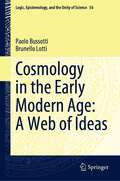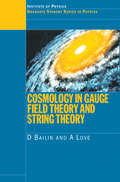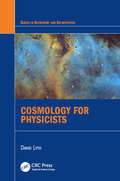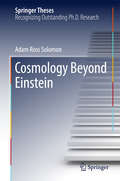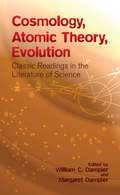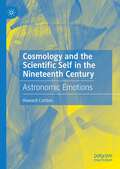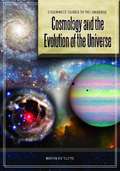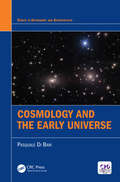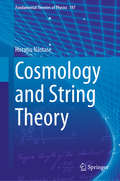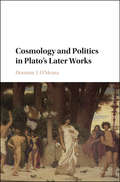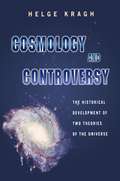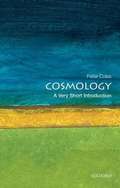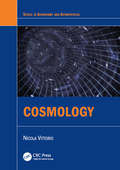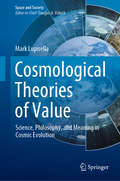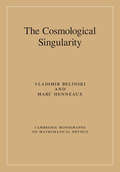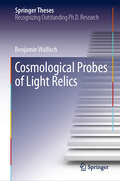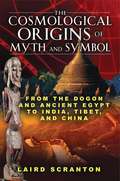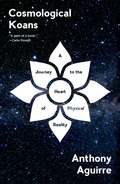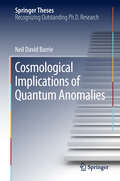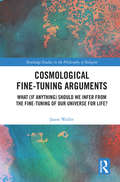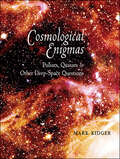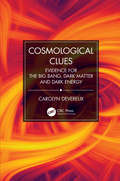- Table View
- List View
Cosmology in the Early Modern Age: A Web of Ideas (Logic, Epistemology, and the Unity of Science #56)
by Paolo Bussotti Brunello LottiThis volume addresses the history and epistemology of early modern cosmology. The authors reconstruct the development of cosmological ideas in the age of ‘scientific revolution’ from Copernicus to Leibniz, taking into account the growth of a unified celestial-and-terrestrial mechanics. The volume investigates how, in the rise of the new science, cosmology displayed deep and multifaceted interrelations between scientific notions (stemming from mechanics, mathematics, geometry, astronomy) and philosophical concepts. These were employed to frame a general picture of the universe, as well as to criticize and interpret scientific notions and observational data.This interdisciplinary work reconstructs a conceptual web pervaded by various intellectual attitudes and drives. It presents an historical–epistemological unified itinerary which includes Copernicus, Kepler, Galileo, Descartes, Huygens, Newton and Leibniz. For each of the scientists and philosophers, a presentation and commentary is made of their cosmological views, and where relevant, outlines of their most relevant physical concepts are given. Furthermore, the authors highlight the philosophical and epistemological implications of their scientific works. This work is helpful both as a synthetic overview of early modern cosmology, and an analytical exposition of the elements that were intertwined in early-modern cosmology. This book addresses historians, philosophers, and scientists and can also be used as a research source book by post-graduate students in epistemology, history of science and history of philosophy.
Cosmology in Gauge Field Theory and String Theory
by D. Bailin A. LoveCosmology in Gauge Field Theory and String Theory focuses on the cosmological implications of the gauge theories of particle physics and of string theory. The book first examines the universe's series of phase transitions in which the successive gauge symmetries of the higher-temperature phase were spontaneously broken after the big bang, discussing relics of these phase transitions, more generic relics (baryons, neutrinos, axions), and supersymmetric particles (neutralinos and gravitinos). The author next studies supersymmetric theory, supergravity theory, and the constraints on the underlying field theory of the universe's inflationary era. The book concludes with a discussion of black hole solutions of the supergravity theory that approximates string theory at low energies and the insight that string theory affords into the microscopic origin of the Bekenstein-Hawking entropy.Cosmology in Gauge Field Theory and String Theory provides a modern introduction to these important problems from a particle physicist's perspective. It is intended as an introductory textbook for a first course on the subject at a graduate level.
Cosmology for Physicists (Series in Astronomy and Astrophysics)
by David LythWritten by an award-winning cosmologist, this brand new textbook provides advanced undergraduate and graduate students with coverage of the very latest developments in the observational science of cosmology. The book is separated into three parts; part I covers particle physics and general relativity, part II explores an account of the known history of the universe, and part III studies inflation. Full treatment of the origin of structure, scalar fields, the cosmic microwave background and the early universe are provided. Problems are included in the book with solutions provided in a separate solutions manual. More advanced extension material is offered in the Appendix, ensuring the book is fully accessible to students with a wide variety of background experience. Features: Incorporates the latest experimental results, at a time of rapid change in the field Explores the origin of structure and the Cosmic Microwave Background Includes an extensive number of problems and a corresponding solutions manual
Cosmology Beyond Einstein
by Adam Ross SolomonThis work investigates the theoretical and cosmological implications of modifying Einstein's theory of general relativity. It explores two classes of modifications to gravity: those in which the graviton is given a small mass, and those in which Lorentz invariance is spontaneously broken. It elucidates the nature of cosmological perturbations in theories of massive bimetric gravity, including a potentially deadly instability. Theories of gravity beyond general relativity could explain why the expansion of the Universe is accelerating, obviating the need for a dark energy, and can also affect the evolution of the early Universe. Next, it investigates the nature of spacetime in massive gravity theories that contain two different spacetime metrics. Lastly, the strongest constraints to date are placed on the size of Lorentz-violating effects in the gravity sector during inflation.
Cosmology, Atomic Theory, Evolution: Classic Readings in the Literature of Science (General Science)
by William Dampier Margaret DampierFrom the biblical book of Genesis to Henri Bergson's Creative Evolution, these extracts from world literature illustrate the development of scientific thought across millennia. Starting with speculations by the ancient Greeks on the structure of the universe, selections on cosmogony include works by Copernicus, Galileo, Newton, Laplace, Foucault, and Einstein. Theories and reports on experimental results concerning the nature of matter range from Paracelsus' writings on alchemy to Faraday's work with electrochemistry and Sir Ernest Rutherford's studies of radioactivity and the structure of the atom. The final section on evolutionary theory begins with Aristotle and Pliny and features landmark works by the giants in the field, among them, Linnaeus, Lamarck, Lyell, Malthus, Darwin, and Mendel. 36 figures. 7 tables.
Cosmology and the Scientific Self in the Nineteenth Century: Astronomic Emotions
by Howard CarltonThis book argues that while the historiography of the development of scientific ideas has for some time acknowledged the important influences of socio-cultural and material contexts, the significant impact of traumatic events, life threatening illnesses and other psychotropic stimuli on the development of scientific thought may not have been fully recognised. Howard Carlton examines the available primary sources which provide insight into the lives of a number of nineteenth-century astronomers, theologians and physicists to study the complex interactions within their ‘biocultural’ brain-body systems which drove parallel changes of perspective in theology, metaphysics, and cosmology. In doing so, he also explores three topics of great scientific interest during this period: the question of the possible existence of life on other planets; the deployment of the nebular hypothesis as a theory of cosmogony; and the religiously charged debates about the ages of the earth and sun. From this body of evidence we gain a greater understanding of the underlying phenomena which actuated intellectual developments in the past and which are still relevant to today’s knowledge-making processes.
Cosmology and the Evolution of the Universe
by Martin RatcliffeWritten with college students in mind, this reference offers a nonmathematical introduction to cosmology, designed to be accessible to nonspecialists. It begins with an overview of early ideas about the universe, from the ancient Egyptians to the modern era; the rest of book covers the 20th century and the early 21st century. Thematic chapters cover topics such as the large-scale structure of the universe, the discovery and importance of cosmic microwave background radiation, and the forces and particles involved in the evolution of the universe. Each chapter concludes with a list of print and electronic resources, and an annotated general bibliography at the end of the book lists general works or those of particular significance. Sidebars provide more in-depth information on key people and ideas without interrupting the flow of the main narrative. A glossary of scientific terms is included. The book's 66 b&w illustrations and images are more technical rather than awe-inspiring. Ratcliffe teaches cosmology at Wichita State University. Annotation c2009 Book News, Inc., Portland, OR (booknews.com)
Cosmology and the Early Universe (Series in Astronomy and Astrophysics)
by Pasquale Di BariThis book discusses cosmology from both an observational and a strong theoretical perspective. The first part focuses on gravitation, notably the expansion of the universe and determination of cosmological parameters, before moving onto the main emphasis of the book, the physics of the early universe, and the connections between cosmological models and particle physics. The book provides links with particle physics and with investigations of the theories beyond the Standard Model, especially in connection to dark matter and matter-antimatter asymmetry puzzles. Readers will gain a comprehensive account of cosmology and the latest observational results, without requiring prior knowledge of relativistic theories, making the text ideal for students. Features: Provides a self-contained discussion of modern cosmology results without requiring any prior knowledge of relativistic theories, enabling students to learn the first rudiments needed for a rigorous comprehension of cosmological concepts Contains a timely discussion of the latest cosmological results, including those from WMAP and the Planck satellite, and discuss the cosmological applications of the Nobel Prize 2017 awarded discovery of gravitational waves by the LIGO interferometer and the very high energy neutrinos discovered by the IceCube detector Includes original figures complementing mathematical derivations and accounting for the most important cosmological observations, in addition to a wide variety of problems with a full set of solutions discussed in detail in an accompanying solutions manual (available upon qualifying course adoption) To view the errata please visit the authors personal <a href=":http//www.southampton.ac.uk/~pdb1d08/">webpage.
Cosmology and String Theory (Fundamental Theories of Physics #197)
by Horaţiu NăstaseCosmology describes the evolution of the Universe and is based on a description of its beginning from quantum fluctuations. String theory is the only known consistent theory of quantum gravity that can deal with the highest energy scales near the Planck energy, relevant for cosmology's beginning. As a result, only string theory can give a fully consistent picture of cosmological origins. This book describes the best current avenues for obtaining cosmology from string theory. It is aimed at graduate students, and also researchers, with some familiarity with cosmology and string theory, however no detailed knowledge is required.
Cosmology and Politics in Plato’s Later Works
by O’meara Dominic J.Knowledge of the structure of the cosmos, Plato suggests, is important in organizing a human community which aims at happiness. This book investigates this theme in Plato's later works, the Timaeus, Statesman, and Laws. Dominic J. O'Meara proposes fresh readings of these texts, starting from the religious festivals and technical and artistic skills in the context of which Plato elaborates his cosmological and political theories, for example the Greek architect's use of models as applied by Plato in describing the making of the world. O'Meara gives an account of the model of which Plato's world is an image; of the mathematics used in producing the world; and of the relation between the cosmic model and the political science and legislation involved in designing a model state in the Laws. Non-specialist scholars and students will be able to access and profit from the book.
Cosmology and Controversy: The Historical Development of Two Theories of the Universe
by Helge KraghFor over three millennia, most people could understand the universe only in terms of myth, religion, and philosophy. Between 1920 and 1970, cosmology transformed into a branch of physics. With this remarkably rapid change came a theory that would finally lend empirical support to many long-held beliefs about the origins and development of the entire universe: the theory of the big bang. In this book, Helge Kragh presents the development of scientific cosmology for the first time as a historical event, one that embroiled many famous scientists in a controversy over the very notion of an evolving universe with a beginning in time. In rich detail he examines how the big-bang theory drew inspiration from and eventually triumphed over rival views, mainly the steady-state theory and its concept of a stationary universe of infinite age. In the 1920s, Alexander Friedmann and Georges Lemaître showed that Einstein's general relativity equations possessed solutions for a universe expanding in time. Kragh follows the story from here, showing how the big-bang theory evolved, from Edwin Hubble's observation that most galaxies are receding from us, to the discovery of the cosmic microwave background radiation. Sir Fred Hoyle proposed instead the steady-state theory, a model of dynamic equilibrium involving the continuous creation of matter throughout the universe. Although today it is generally accepted that the universe started some ten billion years ago in a big bang, many readers may not fully realize that this standard view owed much of its formation to the steady-state theory. By exploring the similarities and tensions between the theories, Kragh provides the reader with indispensable background for understanding much of today's commentary about our universe.
Cosmology: A Very Short Introduction
by Peter ColesWritten in simple and accessible language, this non-technical introduction to cosmology, or the creation and development of the universe, explains the discipline, covers its history, details the latest developments, and explains what is known, what is believed, and what is purely speculative. In addition, the author discusses the development of the Big Bang theory, and more speculative modern issues like quantum cosmology, superstrings, and dark matter.
Cosmology
by Edward HarrisonCosmology: The Science of the Universe is a broad introduction to the science of modern cosmology, with emphasis on its historical origins. The first edition of this best-selling book received worldwide acclaim for its lucid style and wide-ranging exploration of the universe. This eagerly awaited second edition updates and greatly extends the first with seven new chapters that explore early scientific cosmology, Cartesian and Newtonian world systems, cosmology after Newton and before Einstein, special relativity, observational cosmology, inflation and creation of the universe. All chapters conclude with a section entitled Reflections containing provocative topics that will foster lively debate. The new Projects section, also at the end of each chapter, raises questions and issues to challenge the reader.
Cosmology (Series in Astronomy and Astrophysics)
by Nicola VittorioModern cosmology has changed significantly over the years, from the discovery to the precision measurement era. The data now available provide a wealth of information, mostly consistent with a model where dark matter and dark energy are in a rough proportion of 3:7. The time is right for a fresh new textbook which captures the state-of-the art in cosmology. Written by one of the world's leading cosmologists, this brand new, thoroughly class-tested textbook provides graduate and undergraduate students with coverage of the very latest developments and experimental results in the field. Prof. Nicola Vittorio shows what is meant by precision cosmology, from both theoretical and observational perspectives. This book is divided into three main parts: Part I provides a pedagogical, but rigorous, general relativity-based discussion of cosmological models, showing the evidence for dark energy, the constraints from primordial nucleosynthesis and the need for inflation Part II introduces density fluctuations and their statistical description, discussing different theoretical scenarios, such as CDM, as well as observations Part III introduces the general relativity approach to structure formation and discusses the physics behind the CMB temperature and polarization pattern of the microwave sky Carefully adapted from the course taught by Prof. Vittorio at the University of Rome Tor Vergata, this book will be an ideal companion for advanced students undertaking a course in cosmology. Features: Incorporates the latest experimental results, at a time of rapid change in this field, with balanced coverage of both theoretical and experimental perspectives Each chapter is accompanied by problems, with detailed solutions The basics of tensor calculus and GR are given in the appendices
Cosmological Theories of Value: Science, Philosophy, and Meaning in Cosmic Evolution (Space and Society)
by Mark LupisellaBuilding from foundations of modern science and cosmic evolution, as well as psychological and philosophical perspectives of value and meaning, this book explores some of humanity’s biggest questions: · Is the Universe “about something”? · What might be roles for life and intelligence in cosmic evolution? · How might we think about value, meaning, purpose, and ethics in a cosmic evolutionary context? The author explores how the sciences of relativity and quantum theory, combined with cosmic evolution and philosophical traditions such as process philosophy, contribute to the development of a broad “relationalist framework”. That framework helps inform perspectives such as “scientific minimalism” and “cosmological theories of value”. Cosmological Reverence, Cosmocultural Evolution, and the Connection-Action Principle are explored as examples of cosmological theories of value, all of which help inform how we might think about ethics, value, and meaning in a cosmic context – including application to the search for extraterrestrial life and the future of intelligence in the universe. This book will benefit a diverse range of practitioners in philosophy, science, and policy, including interdisciplinary fields such as Science and Society and cultural evolution studies. From the Foreword: “This volume ranges from the sciences of cosmic evolution, relativity, and quantum mechanics, to value theory and process philosophy, all with the goal of exploring how they relate to humanity in the sense of worldviews and meaning. With his three cosmological theories of value, Lupisella goes beyond the bounds of most books on naturalism, and into fundamental questions about the nature of the universe and our relation to it. To read Lupisella is to have a mind-boggling experience, to want to race to references, to want to know more.” Steven J. Dick Former Baruch S. Blumberg NASA/ Library of Congress Chair in Astrobiology Former NASA Chief Historian
The Cosmological Singularity (Cambridge Monographs on Mathematical Physics)
by Marc Henneaux Vladimir BelinskiWritten for researchers focusing on general relativity, supergravity, and cosmology, this is a self-contained exposition of the structure of the cosmological singularity in generic solutions of the Einstein equations, and an up-to-date mathematical derivation of the theory underlying the Belinski-Khalatnikov-Lifshitz (BKL) conjecture on this field. Part I provides a comprehensive review of the theory underlying the BKL conjecture. The generic asymptotic behavior near the cosmological singularity of the gravitational field, and fields describing other kinds of matter, is explained in detail. Part II focuses on the billiard reformulation of the BKL behavior. Taking a general approach, this section does not assume any simplifying symmetry conditions and applies to theories involving a range of matter fields and space-time dimensions, including supergravities. Overall, this book will equip theoretical and mathematical physicists with the theoretical fundamentals of the Big Bang, Big Crunch, Black Hole singularities, the billiard description, and emergent mathematical structures.
Cosmological Probes of Light Relics (Springer Theses)
by Benjamin WallischThe wealth of recent cosmic microwave background and large-scale structure data has transformed the field of cosmology. These observations have not only become precise enough to answer questions about the universe on the largest scales, but also to address puzzles in the microscopic description of Nature. This thesis investigates new ways of probing the early universe, the properties of neutrinos and the possible existence of other light particles. In particular, based on detailed theoretical insights and novel analyses, new evidence for the cosmic neutrino background is found in the distribution of galaxies and in cosmic microwave background data. This tests the Standard Model of particle physics and the universe back to a time when it was about one second old. Furthermore, it is demonstrated that future observations will be capable of probing physics beyond the Standard Model since they can achieve a particular target which would either allow the detection of any light particles that have ever been in thermal equilibrium or imply strong bounds on their properties.
Cosmological Physics
by J. A. PeacockThis eagerly-awaited textbook provides advanced undergraduate and graduate students with a complete introduction to modern cosmology. It successfully bridges the gap between undergraduate and advanced graduate texts by discussing topics of current research, starting from first principles. Throughout this authoritative volume, emphasis is given to the simplest, most intuitive explanation for key equations used by researchers. The first third of the book carefully develops the necessary background in general relativity and quantum fields. The rest of the book then provides self-contained accounts of all the key topics in contemporary cosmology, including inflation, topological defects, gravitational lensing, galaxy formation, large-scale structure and the distance scale. To aid understanding, the book is well illustrated with helpful figures and includes outline solutions to nearly 100 problems. All necessary astronomical jargon is clearly explained, ensuring the book is self-contained for any student with undergraduate physics.
The Cosmological Origins of Myth and Symbol: From the Dogon and Ancient Egypt to India, Tibet, and China
by Laird ScrantonReconstructs a theoretic parent cosmology that underlies ancient religion • Shows how this parent cosmology provided the conceptual origins of written language • Uses techniques of comparative cosmology to synchronize the creation traditions of the Dogon, ancient Egyptians, and ancient Buddhists • Applies the signature elements of this parent cosmology to explore and interpret the creation tradition of a present-day Tibetan/Chinese tribe called the Na-Khi--the keepers of the world’s last surviving hieroglyphic language Great thinkers and researchers such as Carl Jung have acknowledged the many broad similarities that exist between the myths and symbols of ancient cultures. One largely unexplored explanation for these similarities lies in the possibility that these systems of myth all descended from one common cosmological plan. Outlining the most significant aspects of cosmology found among the Dogon, ancient Egyptians, and ancient Buddhists, including the striking physical and cosmological parallels between the Dogon granary and the Buddhist stupa, Laird Scranton identifies the signature attributes of a theoretic ancient parent cosmology--a planned instructional system that may well have spawned these great ancient creation traditions. Examining the esoteric nature of cosmology itself, Scranton shows how this parent cosmology encompassed both a plan for the civilized instruction of humanity as well as the conceptual origins of language. The recurring shapes in all ancient religions were key elements of this plan, designed to give physical manifestation to the sacred and provide the means to conceptualize and compare earthly dimensions with those of the heavens. As a practical application of the plan, Scranton explores the myths and language of an obscure Chinese priestly tribe known as the Na-Khi--the keepers of the world’s last surviving hieroglyphic language. Suggesting that cosmology may have engendered civilization and not the other way around, Scranton reveals how this plan of cosmology provides the missing link between our macroscopic universe and the microscopic world of atoms.
Cosmological Koans: A Journey To The Heart Of Physical Reality
by Anthony AguirreCosmological Koans invites the reader into an intellectual adventure of the highest order. Through more than fifty Koans—pleasingly paradoxical vignettes following the ancient Zen tradition—leading physicist Anthony Aguirre takes the reader across the world from West to East, and through ideas spanning the age, breadth, and depth of the Universe. Using these beguiling Koans (Could there be a civilization on a mote of dust? How much of your fate have you made? Who cleans the universe?) and a flair for explaining complex science, Aguirre covers cosmic questions that scientific giants from Aristotle to Galileo to Heisenberg have grappled with, from the meaning of quantum theory and the nature of time to the origin of multiple universes. A playful and enlightening book, Cosmological Koans explores the strange hinterland between the deep structure of the physical world and our personal experience of it, giving readers what Einstein himself called “the most beautiful and deepest experience” anyone can have: a sense of the mysterious.
Cosmological Implications of Quantum Anomalies (Springer Theses)
by Neil David BarrieThe successes of the standard models of particle physics and cosmology are many, but have proven incapable of explaining all the phenomena that we observe. This book investigates the potentially important role of quantum physics, particularly quantum anomalies, in various aspects of modern cosmology, such as inflation, the dynamical generation of the visible and dark matter in the universe, and gravitational waves. By doing so, the authors demonstrate that exploring the links between cosmology and particle physics is key to helping solve the mysteries of our Universe.
Cosmological Fine-Tuning Arguments: What (if Anything) Should We Infer from the Fine-Tuning of Our Universe for Life? (Routledge Studies in the Philosophy of Religion)
by Jason WallerIf the physical constants, initial conditions, or laws of nature in our universe had been even slightly different, then the evolution of life would have been impossible. This observation has led many philosophers and scientists to ask the natural next question: why is our universe so "fine-tuned" for life? The debates around this question are wide-ranging, multi-disciplinary, complicated, technical, and (at times) heated. This study is a comprehensive investigation of these debates and the many metaphysical and epistemological questions raised by cosmological fine-tuning. Waller’s study reaches two significant and controversial conclusions. First, he concludes that the criticisms directed at the "multiverse hypothesis" by theists and at the "theistic hypothesis" by naturalists are largely unsuccessful. Neither of these options can plausibly be excluded. Choosing between them seems to turn on primitive (and so hard to justify) metaphysical intuitions. Second, in order to break the philosophical deadlock, Waller moves the debate from the level of universes to the level of possible worlds. Arguing that possible worlds are also "fine-tuned" in an important and interesting sense, Waller concludes that the only plausible explanation for the fine-tuning of the actual world is to posit the existence of some kind of "God-like-thing."
Cosmological Enigmas: Pulsars, Quasars, and Other Deep-Space Questions
by Mark KidgerThe universe is big. Really big. And it gets bigger every day. In Cosmological Enigmas, Mark Kidger weaves together history, science, and science fiction to consider questions about the bigness of space and the strange objects that lie trembling at the edge of infinity. What are quasars, blazars, and gamma-ray bursters? Could we ever travel to the stars? Can we really expect aliens to contact us? From the profound (what evidence do we have to support the big bang theory?) to the bizarre (can there be more than one universe and, if so, how many dimensions does it possess?) to the everyday-yet-profound (why is the sky dark at night?), Kidger explains not only what we know but how we came to know it. Reflecting on how stars shine and what may lie beyond the edge of the universe, Kidger takes us on the ultimate cosmic journey.
Cosmological Enigmas: Pulsars, Quasars, & Other Deep-Space Questions
by Mark KidgerAn astronomer brings the mysteries of space down to earth in this accessible guide to cosmology, astrophysics, and the ageless wonder of the night sky. The universe is big. Really big. And it gets bigger every day. In Cosmological Enigmas, Mark Kidger weaves together history, science, and science fiction to consider questions about the bigness of space and the strange objects that lie trembling at the edge of infinity. What are quasars, blazars, and gamma-ray bursters? Could we ever travel to the stars? Can we really expect aliens to contact us? From the profound (what evidence do we have to support the big bang theory?) to the bizarre (can there be more than one universe and, if so, how many dimensions does it possess?) to the everyday-yet-profound (why is the sky dark at night?), Kidger explains not only what we know about the universe but how we came to know it. Reflecting on how stars shine and what may lie beyond the edge of the universe, Kidger takes us on the ultimate cosmic journey.
Cosmological Clues: Evidence for the Big Bang, Dark Matter and Dark Energy
by Carolyn DevereuxDid the Universe have a beginning? Will it have an end? Or has it always been the same, never changing? This is the subject of cosmology; the study of the Universe, and this book provides a perfect introduction to the subject for anyone that is interested in the wonders of our UniverseThis book provides an accessible overview of the Standard Model of Cosmology, which is explained in six Cosmological Clues, including evidence for the Big Bang and dark matter and dark energy - the keystones of modern cosmology. It takes readers through some of the most exciting questions in cosmology, such as what evidence do we have that the Universe started from the Big Bang? Has dark matter been observed? Will we ever know what dark energy is? Are the multiverses real? And could the Universe be a hologram? This book is an ideal guide for anyone interested in finding out more about our Universe. It will be of interest to those studying cosmology for the first time, including readers without a scientific background, who have an interest in looking up at the stars and wondering where they all came from!Key features: Contains the latest evidence for the Big Bang, dark matter, and dark energy and explores exciting scientific ideas, such as inflation and multiverses Provides a clear explanation of the main theories of how the Universe evolved based on key observations - the Cosmological Clues Gives the reader a concise introduction to the scientific process, using cosmology as the example, and explores why it has been so successful in creating the technologies we have today
